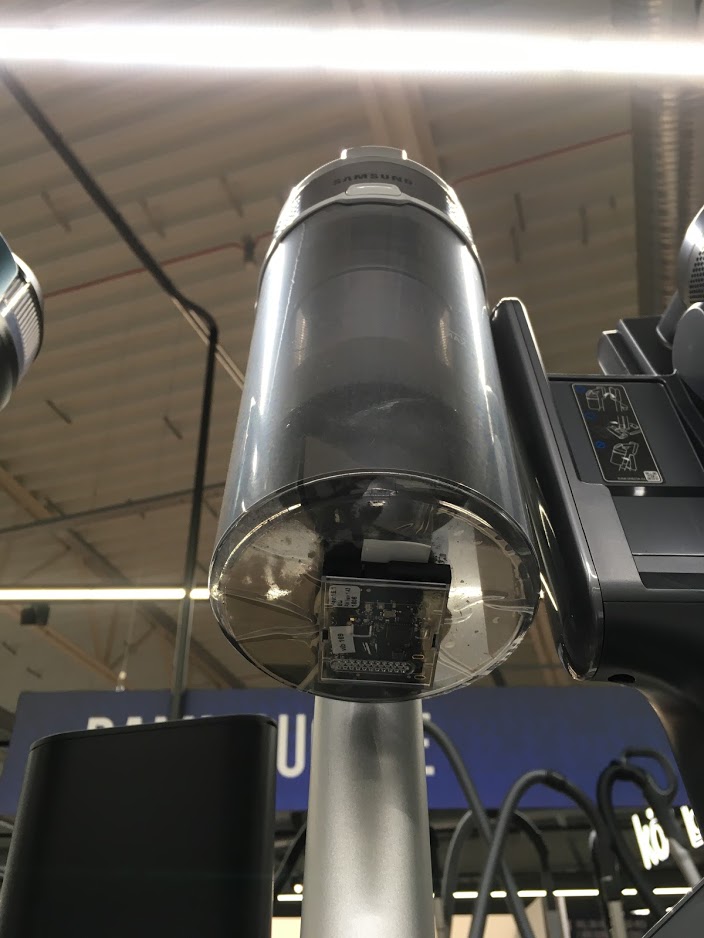
Building an IoT mesh network with simple wireless sensors instead of cameras can help understand shopper behavior. But, why build an IoT mesh network to monitor shoppers? Online retailers know a lot about how their customers are navigating their virtual stores. Offline retailers are not so lucky.
Building a Network
To help offline retailers, one can build their own IoT system to bring customer insights. If you’re going to build your own IoT system, you’ll need two types of wireless sensors:
- Vibration Sensors: trigger when someone is trying out a product
- Light Sensors: trigger when someone is standing in front of a product
With these sensors, we can see what items are most popular, how it correlates to sales data, and how to take action to improve sales. All without collecting any personally identifiable information.
This is what the sensors look like:


This is how the sensors are installed:
Why Use an IoT Mesh Network?
Online retailers and e-commerce have many ways to gain insight into their customers. Examples include seeing the top list of searched-for items and the top list of searched-for items with no results. Physical retailers don’t want to be left behind, and there are now many different ways to monitor shoppers in physical stores.
For example, Amazon Go stores extensively use cameras to track everything that happens inside their stores. Many stores provide free WiFi so that they can track their customers. Unfortunately, these solutions have one common problem: privacy.
Cameras see everything, oftentimes much more than they need. This data is collected and stored. Free WiFi hotspots may capture all kinds of traffic. This is an obvious privacy problem for the shoppers. But it’s not just a problem for the shoppers. It also creates a major problem for the companies storing the data because personally identifiable data is a liability.
This is why, when building your own solution, you should choose vibration sensors and light sensors. These sensors have no liability from owning any personally identifiable information. With only vibration and light, there is nothing there to identify individual shoppers.
Understanding Shopper Behavior
As a shopper, you want to find the best products and ideally pay the lowest possible price. Retailers and producers have slightly different motivations though. Brands want customers to buy their products, and not their competitors while retailers want to sell more products.
When the motivations of shoppers, retailers, and brands align, business is made. And the more business, the better for all. Understanding customer behavior is key to improving the in-store experience for everyone. Sensors detect when people are looking at items, reporting this in real-time so that stores can see where shoppers are.
The data is also posted to a backend database. This allows for a more in-depth analysis of the data to see how consumer behavior changes over time and how it improves sales. To cover large electronics stores, a wireless IoT mesh network can be used.
Why Use an IoT Mesh Network?
A wireless mesh network is a wireless network that automatically extends its range. Even with a longer range, it’s not always enough. Electronics stores can be huge, and there is plenty of metal inside that hampers the wireless coverage.
A mesh network is the ideal technology for:
- Coverage: electronics stores can be huge, but a mesh network can cover it all
- Ease of use: no network planning is needed.
- East to install
- Easy to maintain: if there are coverage issues, extenders can be added as needed
- Robust: if something changes, the network will automatically adapt
This is what the wireless mesh network typically looks like:

In this deployment, the mesh network using one access point and two extenders. Most devices can reach the access point directly, but some chose to talk to one of the extenders.
Battery Life
The sensors for a mesh network are equipped with one coin-cell battery each. IoT mesh systems can be tailored for extreme low-power operation. Extreme low-power operation in this case means that the sensors can go for several months on a single charge. For example, sensors are automatically turned off at night, to conserve their precious power.
However, just optimizing the system isn’t enough. It’s vital to continuously collect power consumption data from each and every sensor. This data displays the exact behavior at any given time. Are there any sensors that behave in a way that require their batteries to be replaced earlier? The system would know the answer to this and alert the proper individuals if this would be the case.
Mesh-to-cloud connectivity
An IoT mesh network can be connected to the Internet via a 4G modem. The network will maintain a stable encrypted connection to the backend system so that the devices can always be reached. If the Internet connection would go down at any point during the deployment, the devices hold off from reporting their data until the Internet connection is restored. With this technique, no data is ever lost.
Technical Details
For building your own IoT mesh network, you can utilize the following:
- IoT mesh Sub-GHz radio technology
- IoT mesh IPv6 6lowpan networking and the RPL mesh routing protocol
- TLS end-to-end encryption
- Channel hopping to avoid problematic radio channels
- Cloud deployment on AWS
The project uses the following hardware components:
Conclusions
Building an IoT system can help retailers understand customer behavior. Instead of using cameras, it’s easy to use simple wireless sensors. This allows for the collection of customer behavior data but without the privacy problems of cameras.
Coinsmart. Beste Bitcoin-Börse in Europa
Source: https://www.iotforall.com/building-an-iot-mesh-network-for-retail



